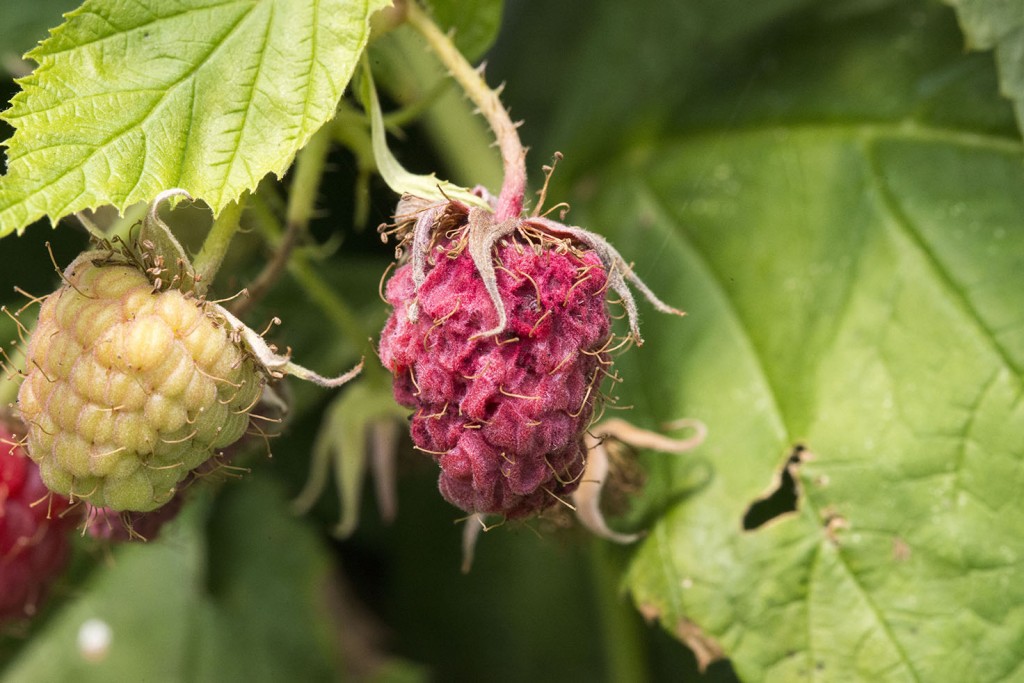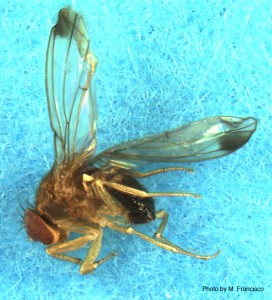Invasive fruit fly threatens NY berries

Raspberry damaged by spotted-wing drosophila. Photo Tim Baker, used with permission
What looks attractive, smells great, has super antioxidant properties, and flies? It could be a new superhero, I suppose: Antioxidant Man, a caped figure of superior hygiene who rescues folks in poor health through the use of antioxidant therapy. Maybe I’ll pitch it to Marvel Comics.
I’m talking about fall raspberries, those mouth-watering, late-season gems that fill our jelly jars and pie crusts with one last taste of sunshine before a killing frost lays all to waste. Along with pineapples, raspberries are one of the most fragrant fruits, although they’re easier to grow in our region than the former. Their bouquet is due to a complex of aromatic esters (not Esters) that make raspberries one of the few flavorings for which modern chemistry has not found a decent artificial substitute.
Spotting the problem

Male spotted wing drosophila. Photomicrogaph: Bonemeal, Creative Commons, some rights reserved
In point of fact, raspberries could use a superhero right about now to fend off a new invasive pest. In 2009, an Asian fly called the spotted-wing drosophila, or SWD for short, was introduced on the West coast, and in 2012 it “discovered” New York State. Its arrival changed everything for autumn berries, including late-maturing blueberries.
Since SWD is technically “only” a fruit fly, why is it a problem? Well, these are not your grandmother’s fruit flies. Wait, that sounds awkward. Unlike respectable fruit flies, the spotted-wing drosophila is too impatient to wait for fruit to get soft and yucky. Most fruit flies need mushy fruit because their eggs would just bounce off a hard, green berry. But SWD comes equipped with a sharp saw and a bad attitude.
The female has a saber-like ovipositor lined with a row of sharp, sclerotized (hardened) teeth. Under magnification, her egg-laying equipment literally looks like a tiny pruning saw. She uses this formidable tool to break the skin on unripe berries—strawberries, blackberries and raspberries are favorites, but blueberries and even grapes are fair game—and insert eggs. As the berry starts to turn color, tiny maggots are maturing inside. Other fruit flies are attracted to rotting fruit; SWD makes fruit rotten.
In raspberries, signs of SWD activity include fruit that may be darker in color or feel softer than usual. Berries may have poor or “off” flavor, or fall to the ground prematurely. Ones brought indoors may begin to spoil faster than normal, even overnight. Droplets of juice on the fruit, or on the plant when the berry is plucked, are other clues. Sometimes berries will seem to “deflate” or dry out. As the infestation progresses, you may even see the adults at dusk or early in the morning.
The male spotted-wing drosophila stands out from other species because he has one spot on each wing. At rest, one can usually see this with the unaided eye. But the fly has to be resting too. Females have no such markings, but can be identified by the aforementioned ovipositors. Magnification is required for this, however. The white larvae are from one to three millimeters long, or in non-metric terms, from small to really small.
SWD can breed in a wide variety of non-crop hosts like elderberry, dogwood, buckthorn, honeysuckle, and even nightshade. In warm weather there can be one generation of SWD per week, with the eggs hatching in as few as twelve hours. As the weather cools down, of course, this takes longer. Eggs and larva become inactive at about 35F, and 33F may even kill some of them.
At this time, SWD are not very cold-hardy, and as far as is known, do not survive the winter in northern NY. Over time, of course, they are likely to slowly adapt to cold. How do they get here? The spotted-wing drosophila arrives on the bus. Really. Or a transport truck.
Fruit shipped from southern California, Florida or other warm locales comes with a free supply of SWD eggs and larvae. It’s unavoidable. Even though commercial berries are now sprayed far more frequently and heavily than ever before, SWD is impossible to completely control. If not for this movement, it is possible that northern NYS might not see SWD at all, because they are weak flyers, and could only migrate northward a bit at a time on powerful storm fronts.
There is no getting rid of SWD, but you can fight them. Select berries that are not as ripe as you would normally pick, and get them refrigerated immediately. Stomp on any berries that fall to the ground so they will dry out faster and not continue to crank out flies. If you are not a licensed pesticide applicator, there are very few pesticides options available. Some over-the-counter sprays like carbaryl can remain toxic for a week or more, and should not be used. But netting your berry patch just after petal drop with a fine-mesh product such as remay row cover or mosquito netting can keep SWD out.
Many efforts are underway to combat this new threat to small fruits. Areas of study include new insecticides, as well as biological controls such as predatory insects and pathogenic fungi and bacteria. At this point, though, the best defense is a good defense. Or a superhero.
For more detailed information, visit http://www.fruit.cornell.edu/spottedwing/ or call your Cornell Cooperative Extension office.
Paul Hetzler is a horticulture and natural resources educator with Cornell Cooperative Extension of St. Lawrence County.
Tags: agriculture, fruit pests, gardening, invasives, raspberry, spotted-wing drosophila








How many plagues were there in the Bible?? First we got late blight, then allium moth, lily beetle, and now this fruit fly. There’s the Asian Longhorned Beetle and the Emerald Ash Borer, oh and, don’t forget Zebra Mussels. As if Japanese Knotweed wasn’t enough, now there’s Garlic Mustard. The only things missing are rattlesnakes to make this party complete.
Some of this can be blamed on climate change, or just plain bad marketing decisions, but the rest seems to be the bastard child of globalization. You can bet that those who have profited so massively from “free trade” agreements won’t be troubled by garden pests….they’ve got people for that.